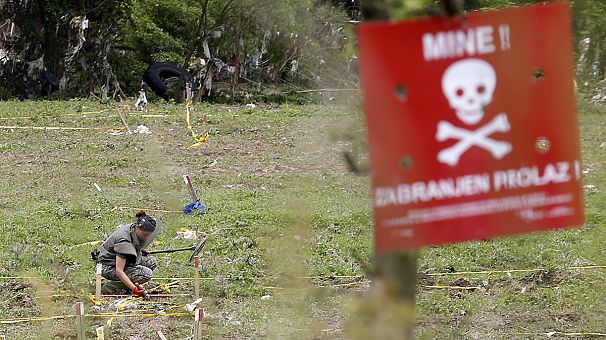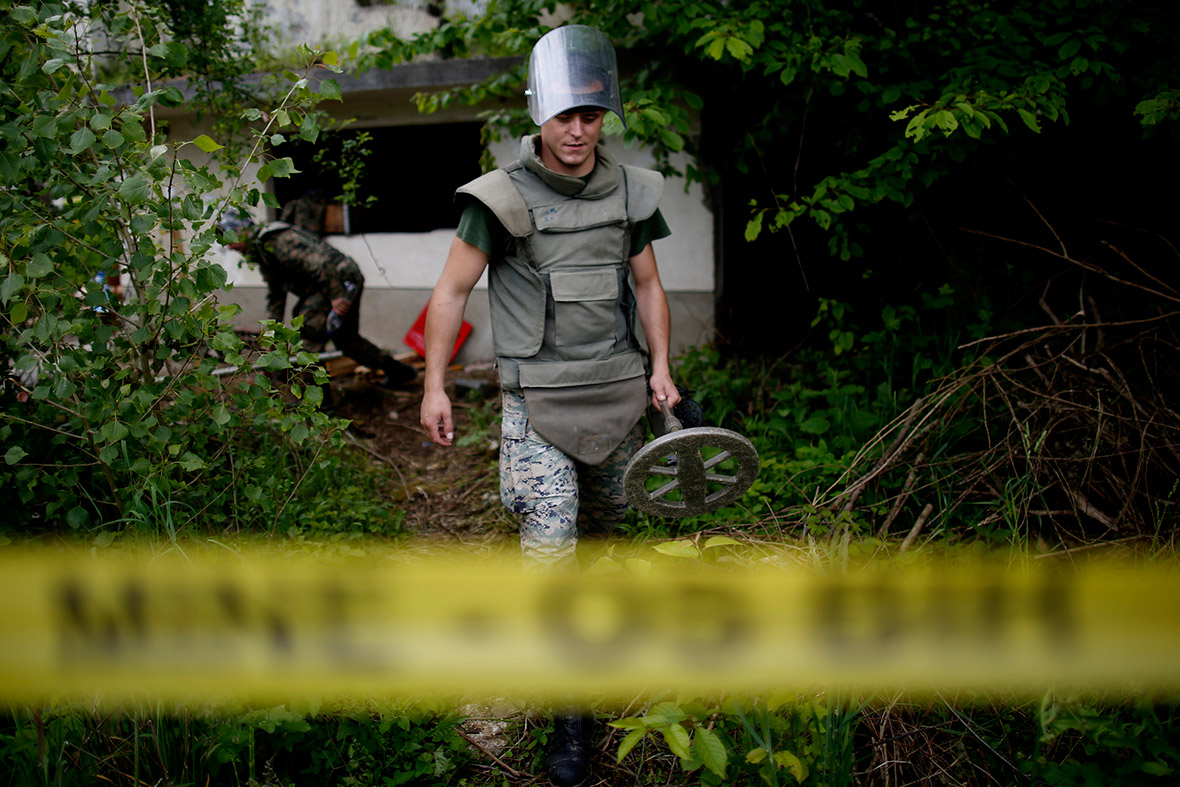
The world's worst stadium disaster occurred exactly 50 years ago in the Peruvian capital Lima. More than 300 people died - but the full story has never been told, and possibly never will be.
"The police didn't let their dogs loose but they did let them tear his clothes off," recalls Hector Chumpitaz, one of Peru's football legends.
"The people were getting disturbed by the way in which they were taking the pitch invader away. It was driving them mad.
"We don't know what would have happened if they had removed him in a peaceful fashion, but we can't think about that now."
Chumpitaz went on to gain more than 100 caps for Peru. He captained the side at the 1970 and 1978 World Cups, but he almost gave up football after this disastrous match, at the start of his international career.
Hosting Argentina on 24 May 1964, Peru were second in the table at the half-way stage of South America's Olympic qualifying tournament. Confidence was high, but with Brazil awaiting in their last game, Peru realistically needed a draw at least against Argentina.
The stadium was packed to its 53,000 capacity, a little over 5% of Lima's population at the time.
"Though we were playing well, they took the lead," Chumpitaz recalls. "We attacked, they defended and this continued until a play came where their defender went to clear - and our player, Kilo Lobaton, raised his foot to block and the ball rebounded into the goal - but the referee said it was a foul, so he disallowed it. This is why the crowd began to get very upset."
In quick succession, two spectators entered the field of play. The first was a bouncer known as Bomba, who tried to hit the referee before being both stopped by police and manhandled off the field. The second, Edilberto Cuenca, then suffered a brutal assault.
"Our very own policemen were kicking him and beating him as if he were the enemy. This is what raised everybody's anger - including mine," says one of the fans in the Estadio Nacional that day, Jose Salas.
Within seconds, the crowd were launching a variety of missiles at the police. A couple of dozen more people were trying to reach the pitch. Reading the mood, Salas and his friends decided to leave.
"The five of us went down the stairs to go out on to the streets - as did many others - but we found the exit gate closed," he says. "So we turned round and started to climb the stairs, which is when the police started throwing the tear gas. At that point, the people in the stands ran into the tunnel to escape - where they met us - causing an enormous crush."
Salas was in the north stand, where the greatest number of tear gas canisters fell - between 12 and 20.
Salas thinks he spent some two hours in a human glacier that slowly edged down the stairs - so tightly packed, he says, that his feet did not touch the floor until he ended up at the bottom, trapped in a pile of bodies, some living some dead.
Records state that most victims died from asphyxiation. But what makes this stadium disaster different from others is what happened on the streets outside.
While some fans who escaped from the stadium managed to open the gates and free those trapped inside, others became involved in a battle with armed police.
"Some lads from my neighbourhood were going by and spotted me. I was quite skinny, and eventually they pulled me out," he says. "But then the shooting began and they started running. The shots were outside - bullets were everywhere. I started to run and didn't look back."
For most of this time, Chumpitaz was also unable to leave.
"After we made it to the dressing rooms, some people went outside and came back saying there had been two deaths. 'Two deaths?' we asked. One would have seemed a lot. We were in the dressing room for two hours before we could leave, so we didn't know the magnitude of what was going on.
"On the way back to our training base, we were listening to the radio and it was 10, 20, 30 deaths. Every time there was news, the number was rising: 50 deaths, 150, 200, 300, 350."
The official number of those who died is 328, but this may be an underestimate, as it does not include anyone killed by gunfire.
There are many eyewitness accounts of people dying of gunshot wounds, but the judge appointed to investigate the disaster, Judge Benjamin Castaneda, was never able to find the bodies to prove it.
Hearing of two corpses with gunshot wounds in Lima's Hospital Loayza, he rushed to inspect them, he told me when I interviewed him 14 years ago. As he arrived, a vehicle was just leaving.
"Reaching the mortuary, I met someone I knew," he said. "I asked him if there were two corpses with bullet wounds. 'Yes,' he told me, 'but they've just taken them away.'"
Some months after the tragedy, Castaneda was visited by an elderly man who said his two sons, both medical students, had travelled from the provinces to attend the game and never returned.
"Even though he had looked for their names among the dead, he could not find them," Castaneda told me.
"He had made further inquiries, but found nothing. So I told him I had news that some people had died after being shot and that, lamentably, I could never discover their identities as everything had been hidden from me."
In his report, Castaneda said the death toll given by the government did not "reflect the true number of victims, since there are well-founded suspicions of secret removals of those killed by bullets".
He went on to accuse the then interior minister of orchestrating the pitch invasion and the brutal police response, in order to incite the crowd to violence - thus providing a pretext for a violent crackdown. The show of strength was intended, he said, to "make the people learn, with blood and tears" the risks they ran if they challenged the authorities.
For its part, the government laid the blame for the trouble on Trotskyist agitators.
Jorge Salazar, a journalist and professor who has written a book about the disaster, says Peruvian society was at the time unusually turbulent.
"It was the sixties, it was Beatles time, Fidel Castro was in fashion - everything was changing in the world," he says.
"In Peru, people were talking for the first time about social justice. There were a lot of demonstrations, worker movements and communist parties. The left was quite powerful, and there was a permanent clash between the police and the people."
Many of the football fans who escaped from the tear gas, certainly wanted revenge on the police. Two policemen were reportedly killed inside the stadium, and battles continued on the streets outside.
Fifty years on, Peruvian Congressman Alberto Beingolea, who has called this weekend for a minute's silence to honour the dead, doubts that the violence was pre-planned by either the government or revolutionaries.
But he doesn't discount the idea that people died from gunshot wounds.
"Two such deaths are possible, especially if you are in a climate of chaos - as happened in that era," he says. "When one generates chaos, the police have to respond - and at any moment, that can result in shooting."
Peru has never made a serious attempt to get to the bottom of the Estadio Nacional disaster, and this may never now be possible.
What we do know is that those punished can be counted on two fingers.
Jorge Azambuja, the police commander who gave the order to fire the tear gas, was sentenced to 30 months in jail.
The other was Judge Castaneda himself. He was fined for submitting his report six months late, and for failing to attend all 328 autopsies as he ought to have done. His report was thrown out.
Now dead, he told me in 2000: "I asked everywhere about the bodies but never found anything. They said - without official confirmation of any kind - they were interred in Callao."
This year, the head of the Peruvian Institute of Sport - one of the country's four Olympic medallists, Francisco Boza - has made an unprecedented effort to contact families affected by the tragedy and to invite them to a long overdue mass, to be held at the Cathedral of Lima on Saturday.
But there is still no plaque on display at the Estadio Nacional to commemorate those who died in football's worst disaster.
Stadium disasters - estimated deaths
1968, Buenos Aires - 74
1971, Glasgow (Ibrox) - 66
1982, Moscow - 66 (reports of 340 deaths never confirmed)
1989, Sheffield (Hillsborough) - 96
1996, Guatemala - 84
2001, Ghana - 126
Saturday 24 May 2014
http://www.bbc.co.uk/news/magazine-27540668



